TAPAS.network | 1 August 2023 | Examining Evidence | Elizabeth Line
Elizabeth line defies elasticity models: modal transfers and generated demand provide new paradigm for high profile changes to network
TAPAS continues its close monitoring of how the new Elizabeth Line is changing transport patterns in London. With new data now available on usage and the origin of passengers, examines some surprising outcomes and their potential implications for those planning similar transformational schemes.

IT IS JUST OVER A YEAR since TAPAS reported in detail, as the Elizabeth line began its phased opening, on the line’s passenger forecasts and the uncertainties around whether they would be realised given all the changes in the economy and society since the original Crossrail plans were first tabled – not least the impact of the pandemic.
We are now able to return to the subject with the benefit of the first comprehensive out-turn data now available, which not only tells a fascinating story but could also be of significance to the transport profession across the UK and beyond.
No previous major UK transport scheme has produced such a wealth of statistics and insights. Transport for London deserves credit for not cutting back on this work while coming under pressure to pare its administrative costs to the bone.
The analysis will obviously benefit TfL and its partners as they evolve the Elizabeth line service and associated provision and marketing and provide the groundwork for future TfL projects.
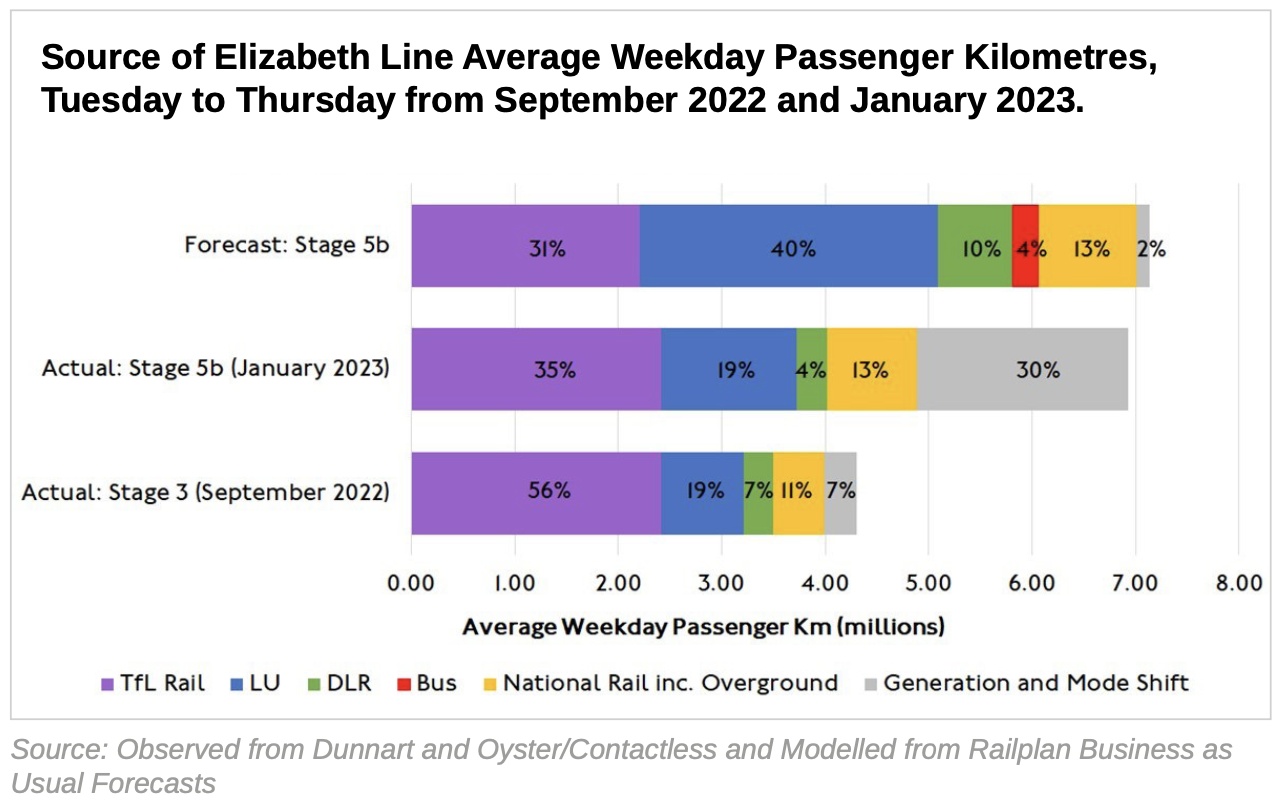
The stand-out finding from the latest statistics is that Elizabeth line passenger numbers from new and mode-shifted journeys are estimated to be more than ten times higher than forecast. This suggests that existing models of elasticity are ill-suited to forecasting demand for projects which deliver transformative changes in journey times and quality.
Last week, the final meeting of Transport for London’s Elizabeth Line Committee received data from monitoring in weeks between September 2022 and January 2023 which were unaffected by strikes and other external events. On average the new line, originally known as Crossrail, carried an average of 550,000 passengers per mid-week day, and almost 600,000 on the busiest days.
In January the line was operating the Stage 5b timetable, covering almost the full Elizabeth line service – introduced on 21 May.
TfL’s research on sources of Elizabeth line journeys finds that, as of January 2023, 30% were journeys generated by the line’s opening or shifted from non-public transport modes. This element was forecast to make up only 2% of the line’s demand at Stage 5b.
Another major departure from the forecasts was that only 19% of Elizabeth line had transferred from London Underground, compared with a forecast 40%.
Abstraction from bus was forecast to account for 4% of Elizabeth line demand but a chart presented to the committee shows no abstraction from bus.
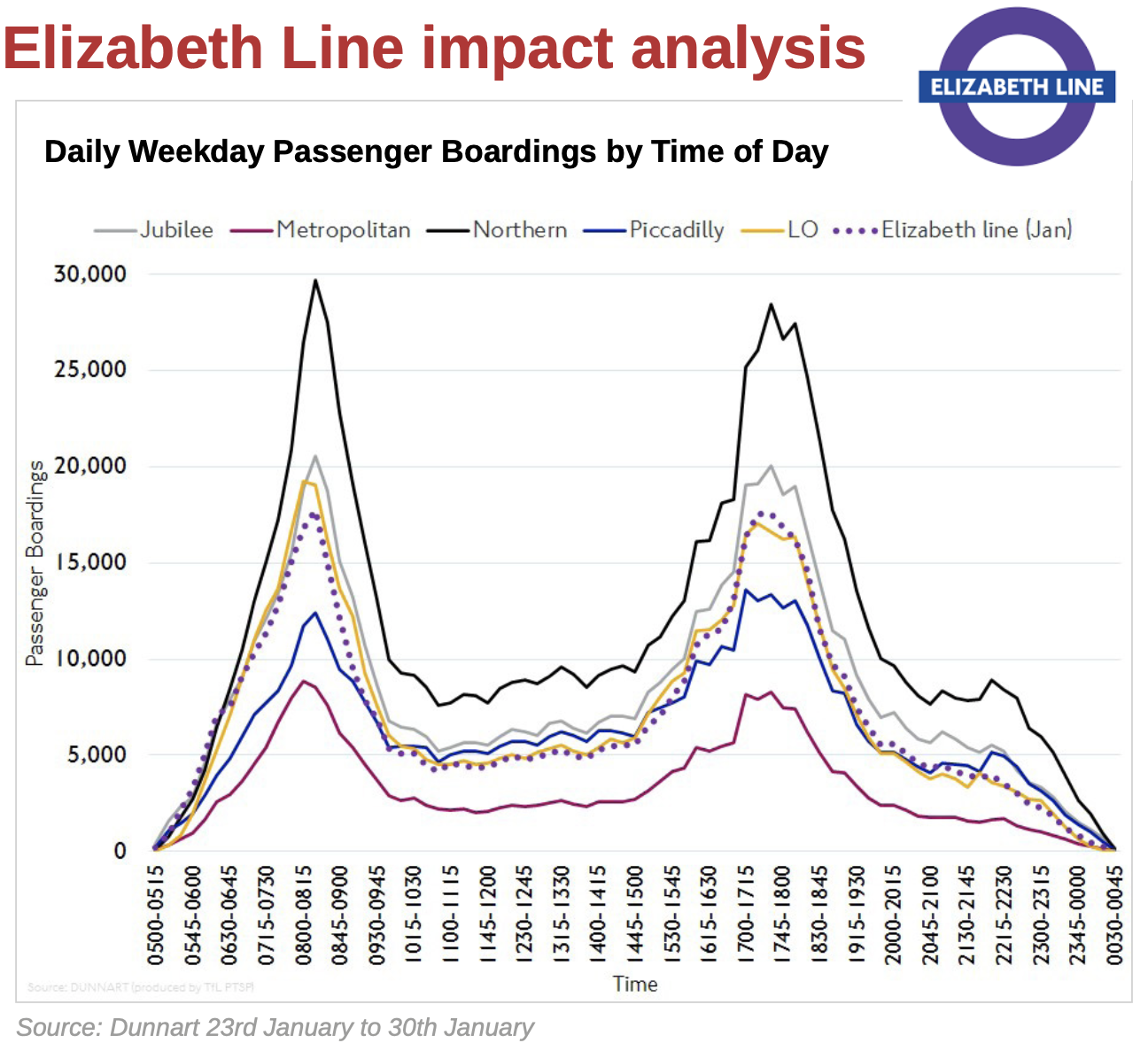
The biggest source of Elizabeth line passengers was the TfL Rail services from Shenfield to Liverpool Street and Paddington to Heathrow and Reading. This was to be expected because the Elizabeth line directly replaced those services, with the added benefit of continuing across London. This source accounts for 35% of passengers, compared with 31% in the forecast.
As was forecast, 13% of Elizabeth line passengers have transferred from other National Rail services, mainly operated by South Eastern and Great Western. The remaining 4% of Elizabeth line demand has come from the Docklands Light Railway.
The abstraction analysis was conducted by comparing flows that are affected by the new line and those that are not, using Oyster and contactless payment data. The report cautions that the statistics should be treated as estimates because many other factors were at play during the analysis period, including post-pandemic recovery, population change and changes to services, fares and fuel prices.
TfL has analysed the demand response to changes in journey time – service elasticity – by applying “big data” approaches to a number of service changes across the network, including the Elizabeth line. The other service changes in the analysis were delivered or assessed from 2019 onwards, including the Northern line extension to Battersea Power Station, the short new passenger railway from Barking to Barking Riverside, closure of Hammersmith Bridge (road) and the impacts of a derailment on the Gospel Oak to Barking line, which is used for a frequent London Overground service as well as freight.
This analysis involved data from three months after each change and then over a longer timeframe, TfL principal transport planner David Warner told LTT.
A report for the committee explained: “Findings suggest the demand response following the changes in journey time brought about by the Elizabeth line is greater than the demand response observed for previously studied service changes.
“This is possibly driven by the larger absolute reductions in journey time, but also by the substantial improvement in travel comfort and ambiance. The ongoing impact of recovery from the pandemic is likely to drive part of this higher response.
“Connectivity, especially in southeast London, has also dramatically improved. The Elizabeth line almost halves journey times from stations in southeast London to Central London: in 20 minutes, passengers can now travel from Abbey Wood to Farringdon, a journey that would have previously taken 39 minutes. There are 1.4 million more jobs across London and the Southeast now accessible within 60 minutes of Abbey Wood than before the central section of the Elizabeth line opened.”
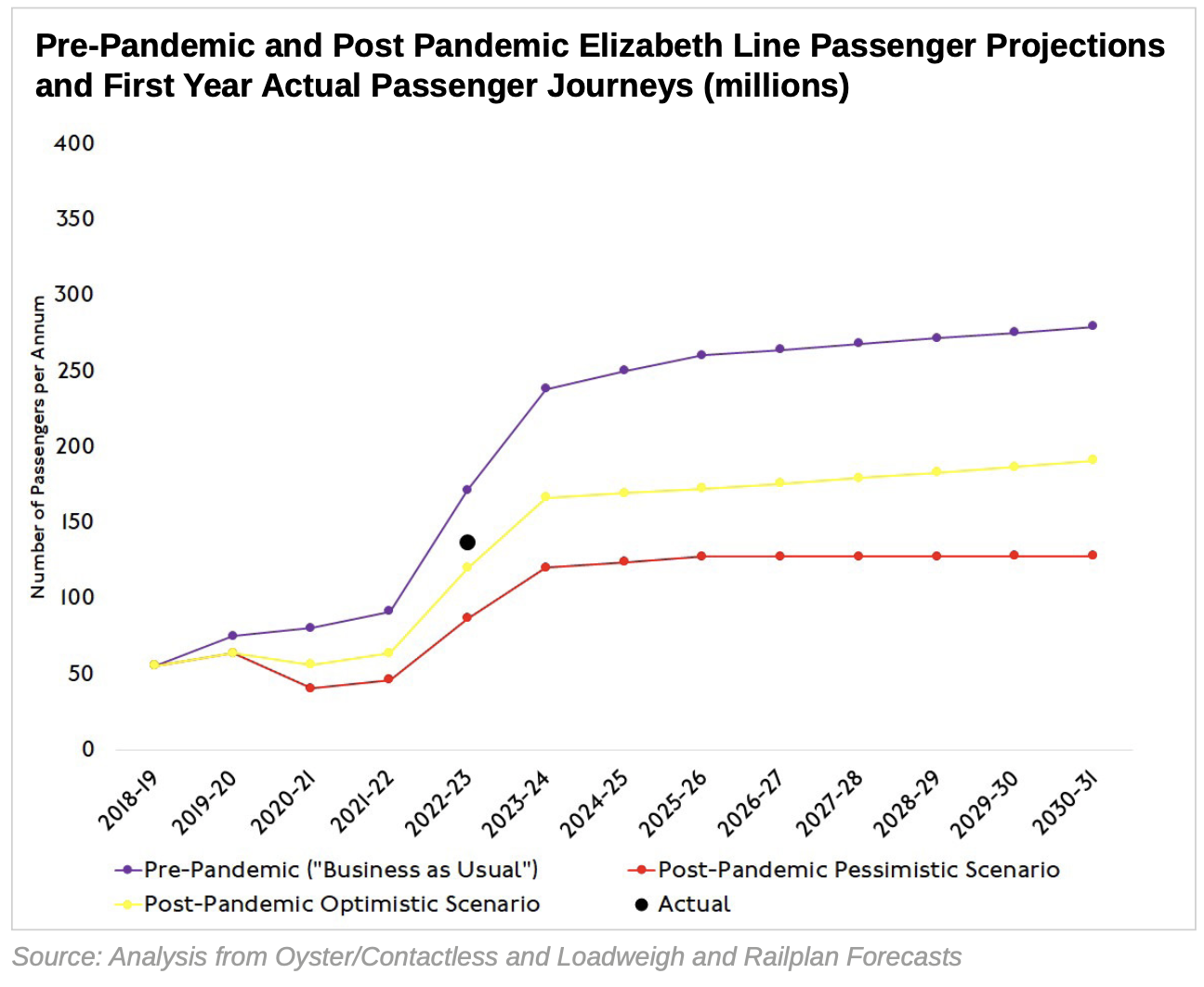
The committee was told some of the trips categorised under “generation and mode shift” could arise from people shifting from non-public transport modes, such as private cars. TfL’s forecasts had suggested that this would be “a small proportion”.
“We believe most of these trips are generated, i.e. these customers would not have made these trips without the existence of the Elizabeth line,” said the report. “Our analysis to date cannot determine the split between mode shift and trip generation, but this will be one of the subjects of the ongoing evaluation study.
“Our estimate of the large portion of new trips (i.e. not travelling in May 2022 before the Elizabeth line opened), relative to our forecasts, is supported by the observed growth in demand at core Elizabeth line stations that cannot be explained by decreases at surrounding stations.” Examples were the areas around Woolwich, Canary Wharf and Tottenham Court Road stations.
“Of the trips we classify as generated, we believe that a significant portion of the generated demand can be viewed as ‘accelerated recovery’ where the rate of recovery from the pandemic has been higher where the Elizabeth line is now available. We see some pieces of evidence for this hypothesis:
(a) the response to the better journey times provided by Elizabeth line is stronger than we would normally expect;
(b) the speed of the demand response to the journey time improvements, particularly for trips from the Shenfield branch to central London; and
(c) the difference between the forecast and observed abstraction (as opposed to the total demand, which is close to forecast). The forecast assumed a steady state in travel habits, with more of the demand coming from LU/DLR than we observed in reality. This implies that those customers could have used LU/DLR for these journeys but chose not to.
“Taken together, these results suggest that a proportion of these ‘new’ trips were ‘ready to travel’, i.e. they had chosen not to use existing services but responded quickly to the change in the network. This is most likely if the customers in question were already travelling and have increased the frequency of their trips, e.g. additional days in the office for ‘hybrid’ workers.”
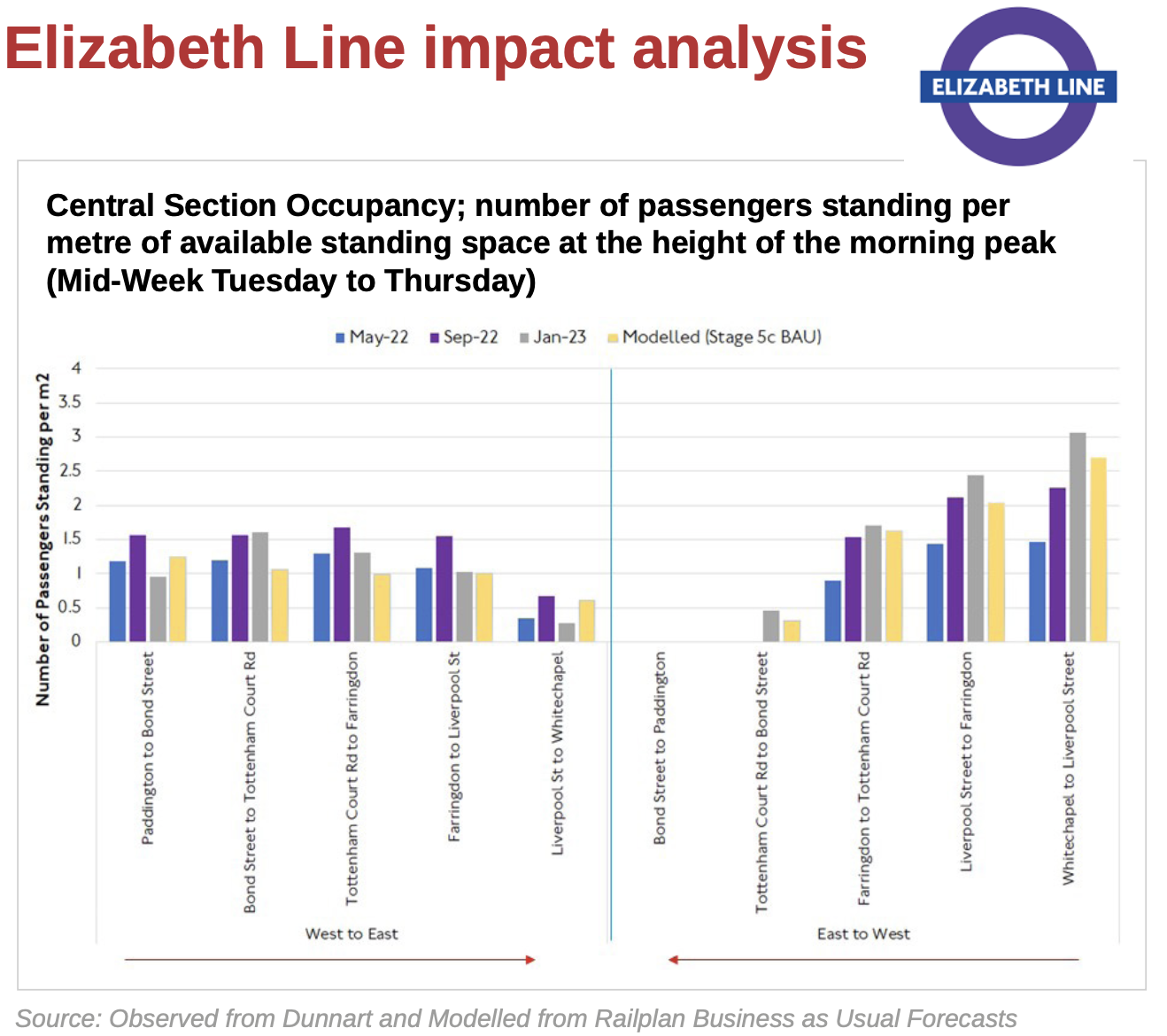
The report said that it was not possible to tell the difference between pandemic recovery and any other type of demand growth, especially as there will have been significant churn in the travelling population in the more than three years since the pandemic began.
“In either case, the transformation in connectivity, journey times and comfort has accelerated demand growth towards (and in some cases beyond) pre-pandemic levels. Overall, the Elizabeth line is attracting an estimated 140,000 additional journeys in London each weekday than otherwise would have been the case.”
TfL will continue to keep services under review as the impacts of abstraction from the latest Elizabeth line timetable change settle, with the aim of ensuring it makes appropriate responses to changes in demand patterns.
A more comprehensive study of abstraction is planned as part of the wider post-opening study over the next two years. This will isolate the array of background factors and build a picture of what may have happened without the Elizabeth line. Extensive passenger surveys will be conducted later this year to understand how and why passengers’ travel behaviour has changed. This will assess the displacement from other modes, including travelling by car or bike.
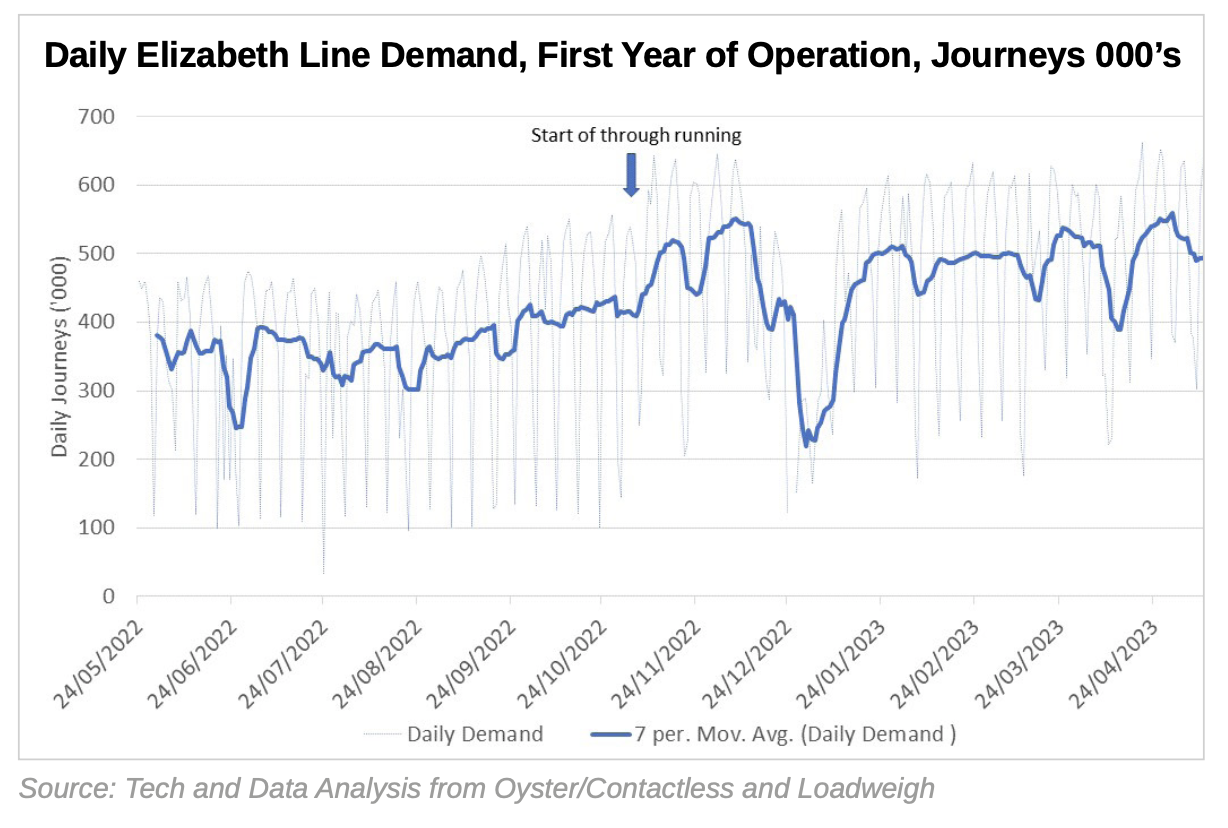
The analysis just published, and others to follow, also present other transport planning bodies with hard evidence to back up their proposals – which could include seeking contributions from landowners and organisations which would benefit from public transport investment as has formed a key part of the Crossrail/Elizabeth line funding model.
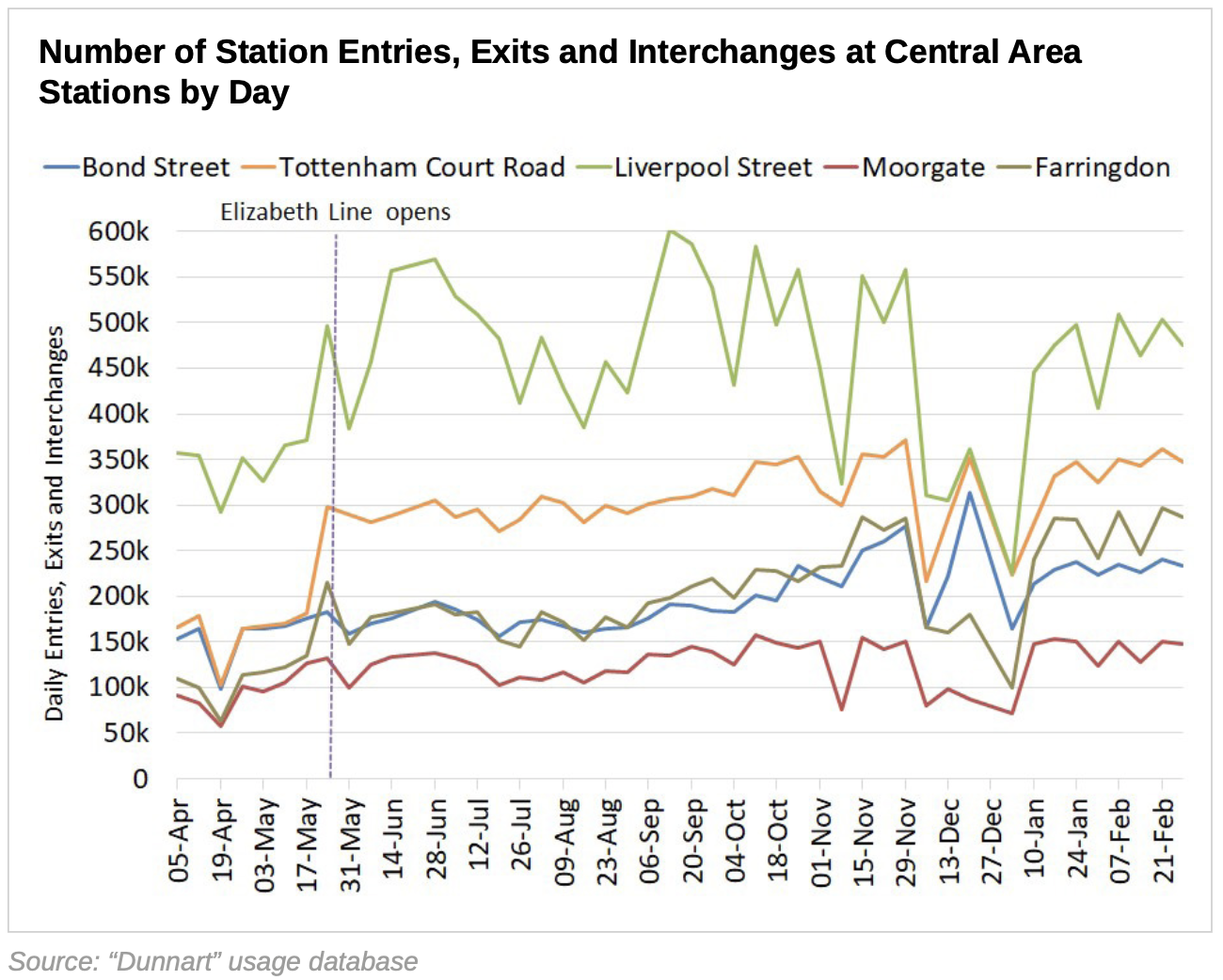
Author: Rhodri Clark
Rhodri Clark is a specialist transport writer based in North Wales. He has been contributing to Local Transport Today since the 1990s, including on Welsh transport developments, and rail issues.
Bus demand changes
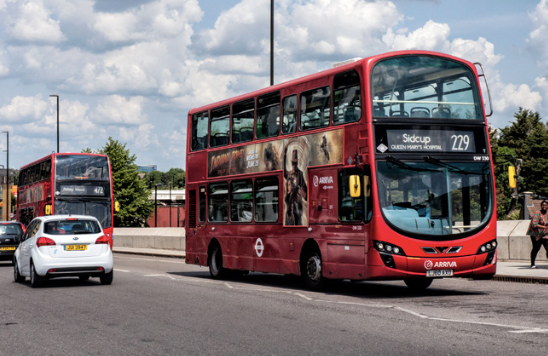
Demand for bus travel to and from Elizabeth line stations outside the central core has “increased substantially” in response to the journey time reductions. Bus boardings around stations on the Western section (west of Paddington) have increased by 15%, on the Eastern section by 13%, and on the Central section excluding Zone 1 by 22%.
This is counterbalance by bus boardings around Elizabeth line stations in Zone 1 decreasing by 8% on average.
“The improvements in journey time to central London via the Elizabeth line from Abbey Wood and Woolwich have also had an impact on the role the local bus network performs as a feeder. Bus boardings around Abbey Wood and Custom House stations more than doubled with the opening of Elizabeth line, and those at Woolwich increased from 28,500 to 31,500 per weekday,” notes the report for the committee.
TfL explained to LTT why its abstraction analysis (see main article) shows nil from buses, despite the observed reduction in bus boardings near central Elizabeth line stations. David Warner, a principal transport planner, said: “The issue here is really a methodological one. Some of the Elizabeth line demand in central London has probably transferred from buses based on the reduced boardings you mention, but some of the generated demand will have also generated additional bus trips to connect to the outer stations.
“Our analysis method isn’t quite fine-grained enough to tell the difference between the two as we’re looking at journeys in (small) aggregates, but to get this level of detail we’d need to look at individual journeys. This is more difficult these days as there is more ‘churn’ in the cards and devices that people use to pay for travel (especially with a larger share of journeys using contactless instead of Oyster) so a ‘new’ customer might actually be the same customer using a different device.”
Tube abstraction is “positive”
LTT asked TfL principal transport planner David Warner whether it was positive or negative, from TfL’s point of view, that Elizabeth line abstraction from London Underground was less than half what was forecast. Did this mean, for example, that Tube crowding has not been alleviated to the expected degree, with the result that pressure will return for additional capacity along certain sections of the Tube network, such as Paddington to Oxford Circus?
Warner replied: “We see the level of generation as positive, as this means the Elizabeth line is bringing more people into London and boosting the economy as it was expected to do.
“The abstraction analysis relies on us constructing a hypothetical alternative without the Elizabeth line, rather than simply looking at before and after. This means that rather than those ‘unabstracted’ Tube customers still being on the Tube, we’re saying that we originally thought they would have used the Tube if Elizabeth line didn’t exist, but now we think they probably wouldn’t have travelled at all. Our evidence for this is based on Oyster/contactless data and the difference in how quickly demand has grown between stations where Elizabeth line affects route choices, versus those where it doesn’t.
“We’re certainly seeing crowding relief where we expected it – for example, the relief along the Central line has allowed us to take more of the fleet for overhauls, when that would have been a much more painful decision to make before.”
Standing room only from Abbey Wood
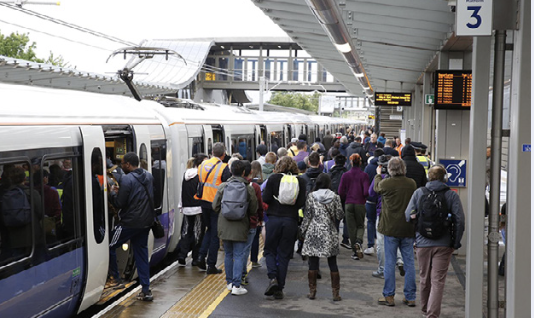
At the height of the morning peak in mid-week, Elizabeth line trains are full on departure from Abbey Wood, the south-eastern terminus. Passengers from Woolwich and Custom House stations have to stand. However, TfL judges that, even at the busiest times, Elizabeth line trains have sufficient capacity for future growth.
Each Class 345 train has a notional capacity of 1,500 passengers, which equates to all seats taken and usable standing space occupied to a density of four passengers per square metre. Data from the on-train passenger counting systems provides detailed insight into loadings on specific trains or at specific times of day. Occupancy is currently at or below three passengers/sqm at the busiest times.
As forecast, the east is busier than the west. At the height of the morning peak on Tuesdays to Thursdays, there are three passengers/sqm between Whitechapel and Liverpool Street (going east to west) and 1.5 passengers/sqm between Paddington and Whitechapel (west to east).

Rhodri Clark is a specialist transport writer based in North Wales. He has been contributing to Local Transport Today magazine since the 1990s, primarily on Welsh subjects. He appears on Welsh radio and TV to comment on transport issues.
You are currently viewing this page as TAPAS Taster user.
To read and make comments on this article you need to register for free as TAPAS Select user and log in.

Log in